Introduction. Pathophysiology and Epidemiology
- Premenstrual syndrome (PMS) is a luteal-phase condition in women.
- Serotonin and gamma-aminobutyric acid (GABA) fluctuations; estrogen and progesterone shifts.
- Abuse in childhood.
- 90% of women have symptoms, 20% have PMS.
- 14-88 % have moderate-to-severe symptoms in adolescence.
The premenstrual syndrome (PMS) is a luteal-phase condition in women, which is characterized emotional, behavioral, and physical changes. Its pathogenesis is complex and not fully understood, and there are several theories trying to explain the origin of this pathological condition. According to the neuroendocrine theory, in the central nervous system of a woman with PMS, there are fluctuations in the level of such significant neurotransmitters as serotonin and gamma-aminobutyric acid (GABA), which affects the course of peripheral neuroendocrine processes (Imai, Ichigo, Matsunami, & Takagi, 2015). In addition, estrogen and progesterone shifts as well as abuse experienced by a woman in her childhood raise the risk of PMS. Recently, much attention has been paid to such potential pathogenic factors as magnesium and calcium deficiencies, which may affect mood and increase appetite. As for epidemiology, the evidence demonstrates that 90 percent of females have the symptoms of PMS, while 20 percent experienced it, of which 10 percent have severe phases. In addition, the manifestations of PMS usually appear in an emotionally unstable and asthenic body type of women engaged in the intellectual sphere of activity.

Risk Factors
- Women with the ovulatory cycle.
- Obesity (BMI over 30).
- Smoking and alcohol.
- Stress, post-traumatic stress disorder (PTSD).
- Competitive sports and older age at menarche (Yonkers & Simoni, 2018).
By the definition, PMS occurs in women with the ovulatory cycle, while there are several risk factors that should be considered while discussing this condition. Obesity is a serious risk that increases PMS development almost twice. Cigarette smoking for a long-period of time as well as often alcohol consumption also may lead to PMS and more severe symptoms. In their study, Czajkowska, Drosdzol-Cop, Gałązka, Naworska, and Skrzypulec-Plinta (2015) revealed that highly intensity of training, competitive sports, and older age at menarche are risk factors for PMS in adolescent girls.
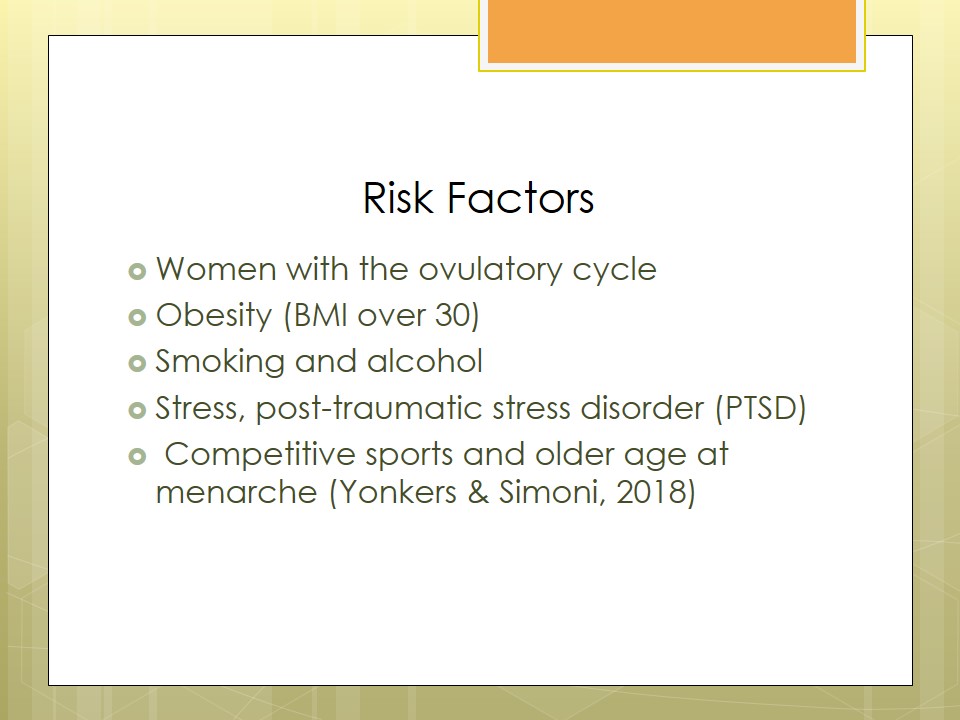
Clinical Assessment
- A (anxiety), C (craving), D (depression), H (hydration), and O (other).
- Mood swings, decreased concentration, aggressiveness, fatigue.
- Headaches and dizziness.
- Acne, itching, pigmentation on the face and body.
The clinical assessment of PMS is notable for its great variability. Psychological disorders include frequent mood swings, increased excitability, decreased concentration, aggressiveness, fatigue, and changes in libido. Neurological signs may be expressed in headaches and dizziness, while dermatological manifestations are acne, itching, pigmentation on the face and body, and dry skin (Brahmbhatt, Sattigeri, Shah, Kumar, & Parikh, 2017). When determining the severity of the clinical presentation, the number of symptomatic manifestations should focus on highlighting the mild and severe form of PMS. In general, five basic categories may be considered: A (anxiety), C (craving), D (depression), H (hydration), and O (other). A minor type of premenstrual syndrome manifests with 3-4 characteristic symptoms that appear 2-10 days before menstruation.

- Differential Diagnoses:
- Premenstrual dysphoric disorder (PMDD);
- Pain somatoform disorder;
- Dysmenorrhea.
- Diagnostic Studies/Labs:
- Daily Record of Severity of Problems (DRSP) charting; Statistical Manual of Mental Disorders (DSM-V);
- Progesterone, estradiol, and prolactin tests.
Premenstrual dysphoric disorder (PMDD) is a state characterized by the concurrent presence of at least five classic PMS symptoms in a particularly severe form. For example, an extremely depressed mood along with a feeling of despair for a long time may signalize about PMDD that usually has a negative effect on a woman’s family and social life and limits her performance. Pain somatoform disorder appears as pain in various parts of the body for at least six months, the physical cause of which cannot be established and which is marked by emotional disorders. In turn, primary dysmenorrhea is a functional violation of the menstrual cycle, which is not associated with any pathology of the pelvic organs. Secondary dysmenorrhea develops against the background of diseases of the reproductive organs and various inflammations. As reported by the Royal College of Obstetricians and Gynaecologists (2016), “in women whose symptom diaries demonstrate noncyclical symptoms, an underlying psychiatric or somatic disorder should be considered” (p. 10). To differentiate between the mentioned diagnoses, it is essential to monitor a patient’s state and pass lab tests.
The key diagnostic criteria for PMS are cyclicality, the periodic nature of complaints occurring before menstruation, and their disappearance after menstruation. The manifestation of five symptoms allows identifying PMS. An important part of the diagnosis is that a patient is expected to keep a diary of self-observation, in which she should note all concerns in her state of health for 2-3 cycles (Royal College of Obstetricians and Gynaecologists, 2016). The study of hormones in the blood (progesterone, estradiol, and prolactin) allows establishing the form of PMS. It is known that the edematous form is accompanied by a decrease in the level of progesterone in the second half of the menstrual cycle. Cephalic, neuropsychiatric, and crisis forms of PMS are characterized by the increase of prolactin.
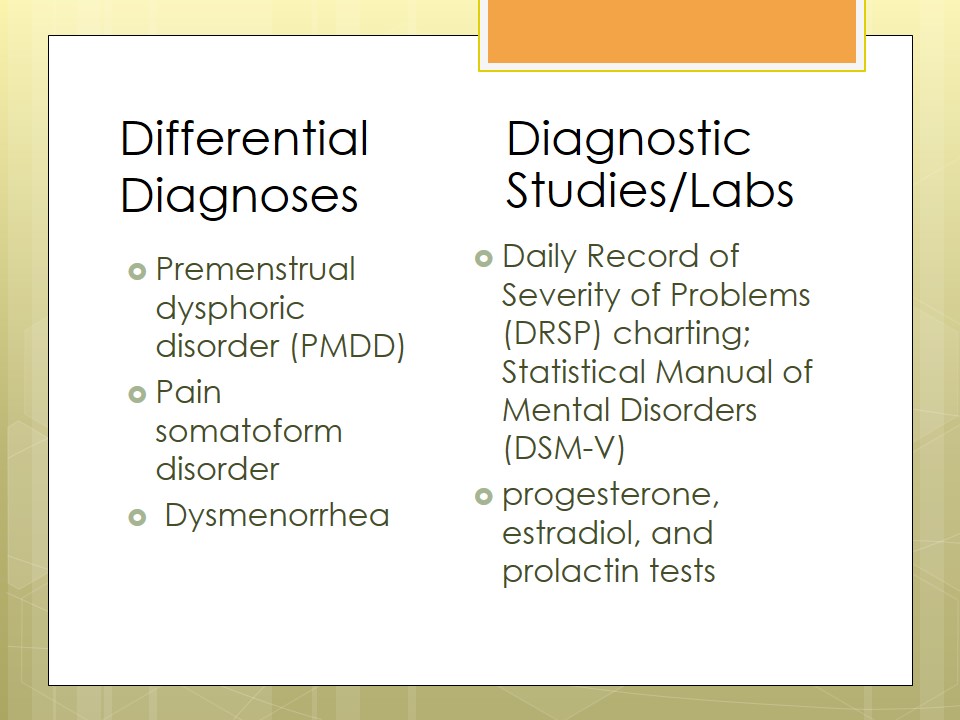
Prevention Options
- Aerobic exercises.
- Healthy nutrition.
- No smoking.
- At least 8 hours of sleep.
- Healthy ways of handling stress.
There is a range of PMS prevention options, of which regular aerobic exercises at least 30 minutes a day help in minimizing concentration difficulties and fatigue. El-Lithy, El-Mazny, Sabbour, and El-Deeb (2015) state that this can be walking, cycling, swimming, skating, dancing, and so on. Regular exercises are likely to not only reduce premenstrual symptoms but also generally improve women’s health. By practicing healthy nutrition, women may also reduce PMS since the dieting with low fat and fast food two weeks before the period enriches the body with necessary nutrients. A lack of sleep is related to a greater risk of anxiety and depression, and by sleeping approximately 8 hours, it is possible to keep one’s mood stable. Yoga, meditation, and free writing may be listed among the ways of handing stress in a healthy way.
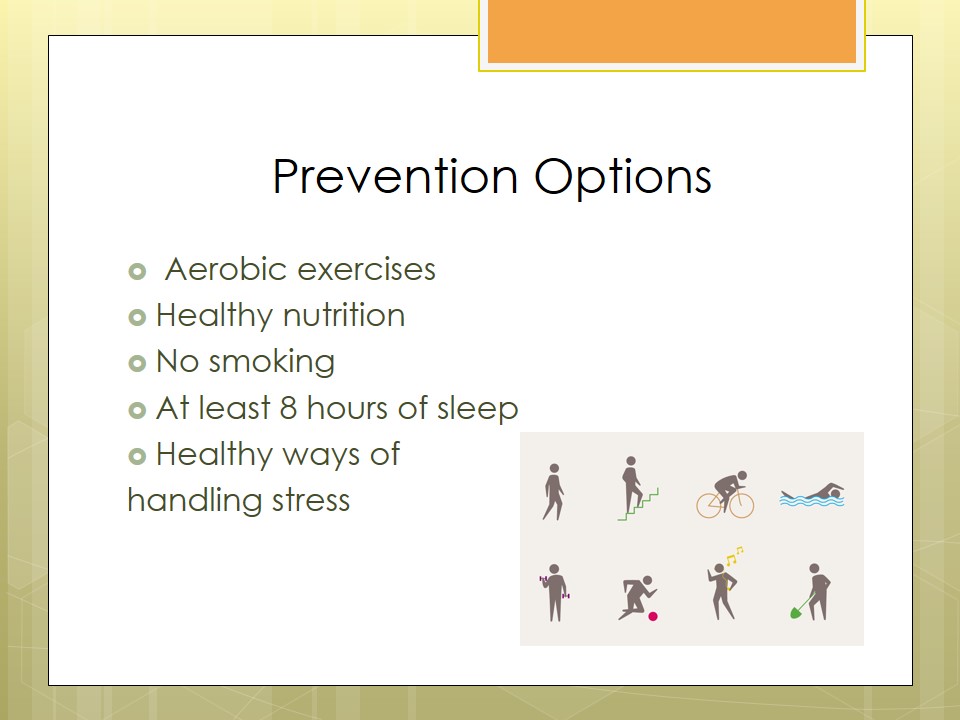
Treatment Options
- Gonadotropin-releasing hormone (GnRH) agonists (Leuprolide (Lupron), nafarelin (Synarel)).
- Pituitary-ovarian axis suppressants(Danazol (Danocrine)).
- Nonsteroidal anti-inflammatory drugs (NSAIDs) (Ibuprofen (Motrin), Tolmetin (Tolectin)).
- Massage, relaxation response, cognitive behavioral therapy.
- Homeopathy.
Gonadotropin-releasing hormone (GnRH) agonists are prescribed to suppress testicular and ovarian steroidogenesis, resulting in hypoestrogenic condition. Pituitary-ovarian axis suppressants are used to cause a hypothalamic-pituitary response and lower estrogen levels (Royal College of Obstetricians and Gynaecologists, 2016). Likewise the above option, it is not recommended for adolescents due to the impact on their bone density. Nonsteroidal anti-inflammatory drugs (NSAIDs) are beneficial for addressing general pain and related dysmenorrhea. Since neuropsychiatric manifestations are expressed in all forms of PMS, almost all patients may be prescribed sedative medications several days before the onset of symptoms. Positive results are shown by the intake of vitamins C, A, and E, which are actively involved in tissue metabolism, and vitamin B6 and calcium alleviate the condition in cases of pronounced depressive mood and aggressiveness (Royal College of Obstetricians and Gynaecologists, 2016). Among non-pharmacological variants, one may note massage, relaxation response, cognitive behavioral therapy, and homeopathy.
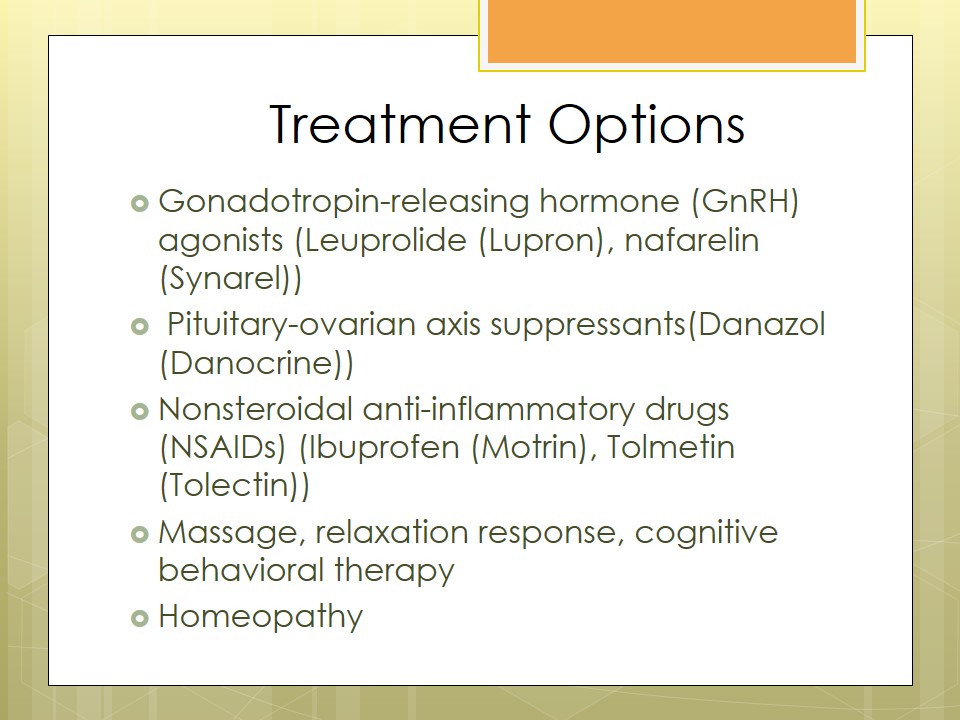
Patient and Family Education
- Recording premenstrual symptoms.
- Women become be more sensitive.
- It is important to find a work-life balance.
- Sources of psychological support.
- Potential treatment options.
A patient should be educated on what to expect before and during PMS She should be explained that recording premenstrual symptoms helps in understanding when they appear. This is useful not only for the patient but also for the doctor to prescribe a suitable treatment and for the family members to be aware of anxiety and depression during (PMS Royal College of Obstetricians and Gynaecologists, 2016). The family should be educated about the fact that women tend to be more sensitive, and even minor conflicts can have a much stronger effect on them. In addition, it should be clear to patients that therapy will help identify emotions and learn how to manage them. Patients need to be explained about the need to find a work-life balance as well as point out some dietary restrictions. For example, in the second phase of the menstrual cycle, it is recommended to restrict the intake of coffee, animal fats, and dairy products. The sources of psychological support and potential treatment options should be presented both to patients and their families.
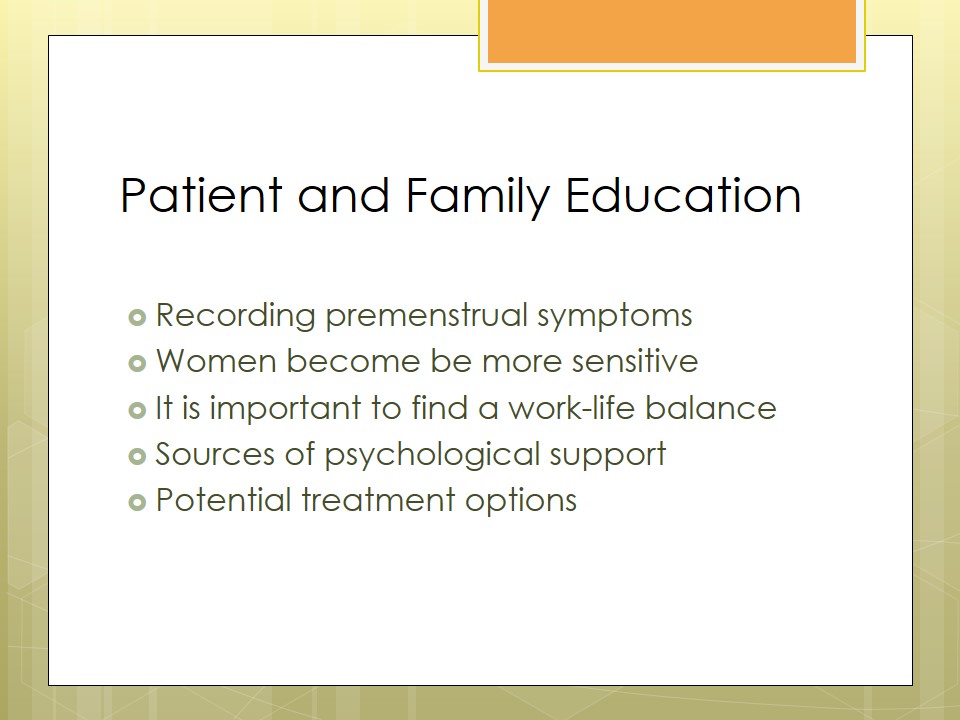
The Best Practices for Optimal Outcomes
- Cognitive behavioral therapy (CBT).
- Self-observation.
- Daily record of problems’ severity.
- Healthy nutrition.
- Relaxation practices (breathing, Yoga).
- Combine pharmacological and non-pharmacological treatment.
- Internal discipline and the steady implementation of all prescriptions.
- Follow-up care (CBT).
Cognitive behavioral therapy (CBT) should be used as a routine treatment option, which allows women to understand how PMS processes affect their thinking and mood changes. An important point is the observance of a balanced diet with the use of a sufficient amount of plant and animal protein, fiber, and vitamins. In the second half of the menstrual cycle, a woman should limit the consumption of carbohydrates, sugar, animal fats, salt, chocolate, caffeine, and alcoholic beverages. It is essential to learn to relax, for example, by trying breathing exercises and meditation technique. This is useful to control headaches, anxiety, and insomnia. Yoga and Pilates are also rather helpful in relieving stress and anxiety.
The combination of pharmacological and non-pharmacological treatment options is the best solution to address all symptoms and increase concentration. It should be remembered that the treatment of PMS is a long process that sometimes continues across the reproductive period of a woman, which requires the internal discipline and the steady implementation of all prescriptions (Royal College of Obstetricians and Gynaecologists, 2016). It may also be recommended to minimize stressful situations before menstruation and increase physical activity.
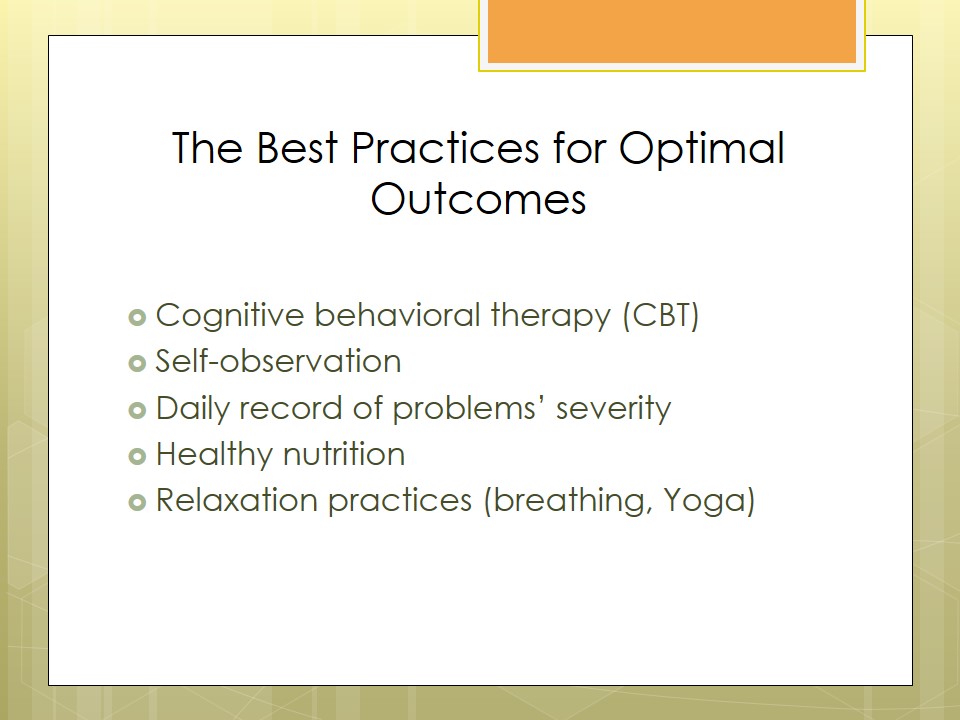
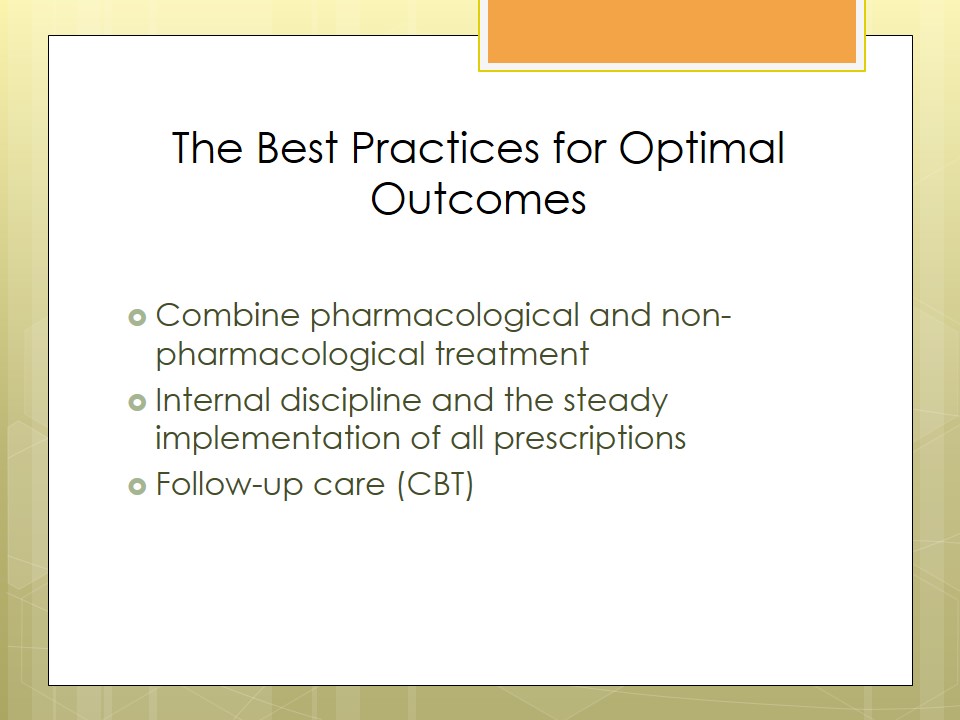
Questions to Peers
- How to distinguish between differential diagnoses of PMS in adult and adolescent patients?
- What are the key non-pharmacological treatment options and how they affect a patient’s physical and psychological health?
- What is the role of symptom diaries and when they should be presented to a doctor?
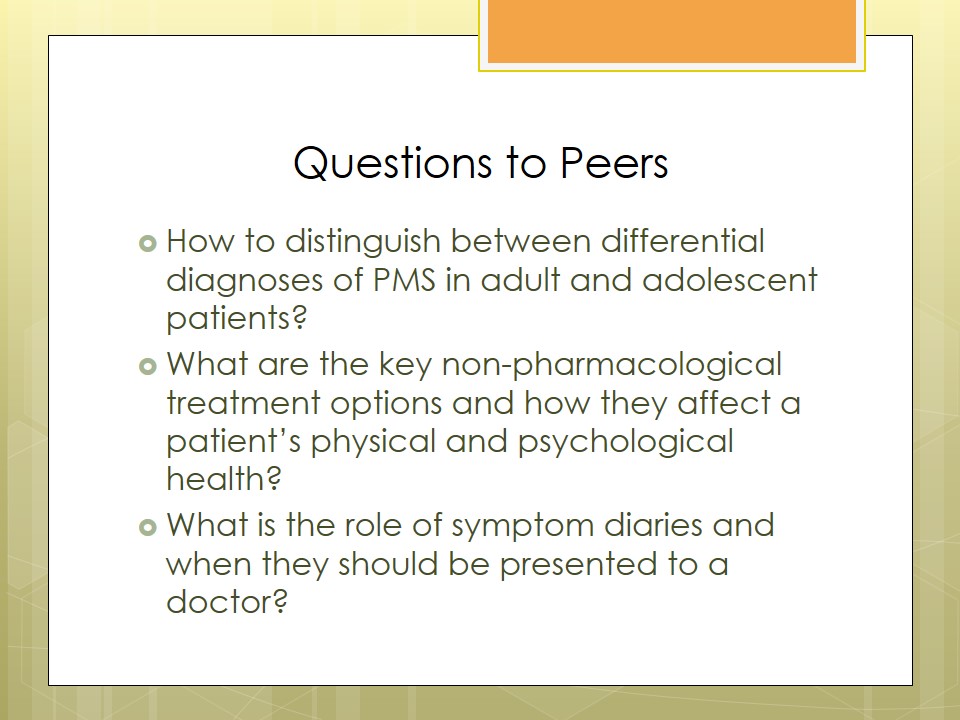
References
Brahmbhatt, S., Sattigeri, B. M., Shah, H., Kumar, A., & Parikh, D. (2017). A prospective survey study on premenstrual syndrome in young and middle aged women with an emphasis on its management. International Journal of Research in Medical Sciences, 1(2), 69-72. Web.
Czajkowska, M., Drosdzol-Cop, A., Gałązka, I., Naworska, B., & Skrzypulec-Plinta, V. (2015). Menstrual cycle and the prevalence of premenstrual syndrome/premenstrual dysphoric disorder in adolescent athletes. Journal of Pediatric and Adolescent Gynecology, 28(6), 492-498. Web.
El-Lithy, A., El-Mazny, A., Sabbour, A., & El-Deeb, A. (2015). Effect of aerobic exercise on premenstrual symptoms, haematological and hormonal parameters in young women. Journal of Obstetrics and Gynaecology, 35(4), 389-392. Web.
Imai, A., Ichigo, S., Matsunami, K., & Takagi, H. (2015). Premenstrual syndrome: Management and pathophysiology. Clinical and Experimental Obstetrics & Gynecology, 42(2), 123-128. Web.
Royal College of Obstetricians and Gynaecologists. (2016). Management of premenstrual syndrome (Green-top guideline no. 48). An International Journal of Obstetrics and Gynaecology, 1-33. Web.
Yonkers, K. A., & Simoni, M. K. (2018). Premenstrual disorders. American Journal of Obstetrics and Gynecology, 218(1), 68-74. Web.